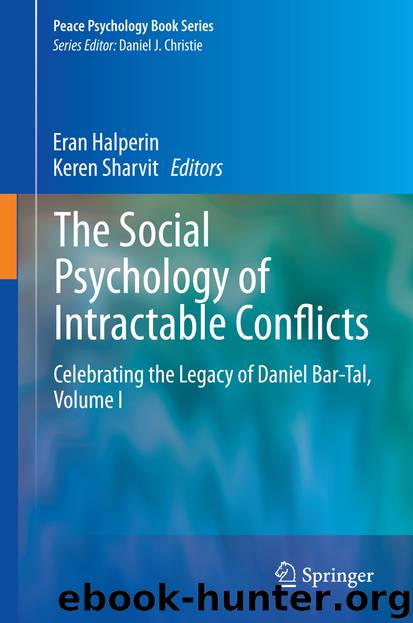The Social Psychology of Intractable Conflicts by Eran Halperin & Keren Sharvit

Author:Eran Halperin & Keren Sharvit
Language: eng
Format: epub
Publisher: Springer International Publishing, Cham
Group-Based Guilt and Shame
Similarly and more importantly for conflict contexts, research shows that people can and sometimes do feel guilt or ashamed for what their group has done in the past, framed as group-based emotions (Branscombe and Doosje 2004). Drawn from social identity and self-categorization theories (Tajfel and Turner 1986; Turner et al. 1987), this general hypothesis provided the basis for the first theorizing and research into group-based guilt and shame, an emotion that can arise when one is reminded of negative actions perpetrated by the ingroup (Branscombe and Doosje 2004; Doosje et al. 1998; Leach et al. 2002).
Lewis’s (1971) distinction between guilt and shame has proved influential. According to Lewis, both emotions are self-conscious and negative, however, with a difference in their focus: feeling guilty for one’s wrongdoing is associated with a focus on specific behaviors and their consequences for the other (“I did this bad thing and now the other is suffering as a result”), whereas feelings of shame involve a greater emphasis on the implications of the wrongdoing for the self (“I did this bad thing and therefore I am a bad person”). Guilt and shame are thought to differ not only in their appraisal focus but also their likely consequences (e.g., Tangney and Fischer 1995). Guilt, with its focus on the misdeeds and their consequences, is thought to lead to attempts at restitution to the victim (e.g., apology, reparation) whereas shame, with its more inward focus, should be more likely to provoke withdrawal or avoidance responses (Lewis 1971; Tangney and Fischer 1995).
However, the precise conceptualization of shame is still under debate. Some have followed Lewis (1971) in regarding shame as the distress that reveals some flaw in one’s essential character (Tangney 1991; Tangney et al. 1996). However, others have defined shame as the distress caused by the public exposure of the wrongdoing (Smith et al. 2002). In this conception, shame is linked to a damaged reputation or a loss of respect and honor in the eyes of others (Crozier 1998; Smith et al. 2002). Of course, these two conceptions are not mutually exclusive and, indeed, both aspects of shame may often be evoked simultaneously.
As stated above and drawn from social identity and self-categorization theories (Tajfel and Turner 1986; Turner et al. 1987), the hypothesis that people derive part of their identity from their social identities provided the basis for the first theorizing and research into group-based guilt and shame, emotions that can arise when one is reminded of negative actions perpetrated by the ingroup (Branscombe and Doosje 2004; Doosje et al. 1998; Leach et al. 2002). A review of the existing literature on guilt and shame at the group level reveals that shame, unlike guilt, has not only been investigated less but that the expressions of both emotions have sometimes been used interchangeably due to the difficulty of empirically distinguishing between them (e.g., Iyer et al. 2003; Leach et al. 2002). In addition, only a few studies have looked at factors associated with both emotional experiences simultaneously (e.
Download
This site does not store any files on its server. We only index and link to content provided by other sites. Please contact the content providers to delete copyright contents if any and email us, we'll remove relevant links or contents immediately.
Rewire Your Anxious Brain by Catherine M. Pittman(18484)
Talking to Strangers by Malcolm Gladwell(13128)
The Art of Thinking Clearly by Rolf Dobelli(10137)
Mindhunter: Inside the FBI's Elite Serial Crime Unit by John E. Douglas & Mark Olshaker(9099)
Becoming Supernatural by Dr. Joe Dispenza(8034)
Change Your Questions, Change Your Life by Marilee Adams(7559)
The Road Less Traveled by M. Scott Peck(7469)
Nudge - Improving Decisions about Health, Wealth, and Happiness by Thaler Sunstein(7456)
The Lost Art of Listening by Michael P. Nichols(7356)
Mastermind: How to Think Like Sherlock Holmes by Maria Konnikova(7157)
Enlightenment Now: The Case for Reason, Science, Humanism, and Progress by Steven Pinker(7081)
Win Bigly by Scott Adams(7031)
The Way of Zen by Alan W. Watts(6448)
Daring Greatly by Brene Brown(6364)
Big Magic: Creative Living Beyond Fear by Elizabeth Gilbert(5550)
Grit by Angela Duckworth(5446)
Ego Is the Enemy by Ryan Holiday(5220)
Men In Love by Nancy Friday(5110)
Altered Sensations by David Pantalony(5001)
